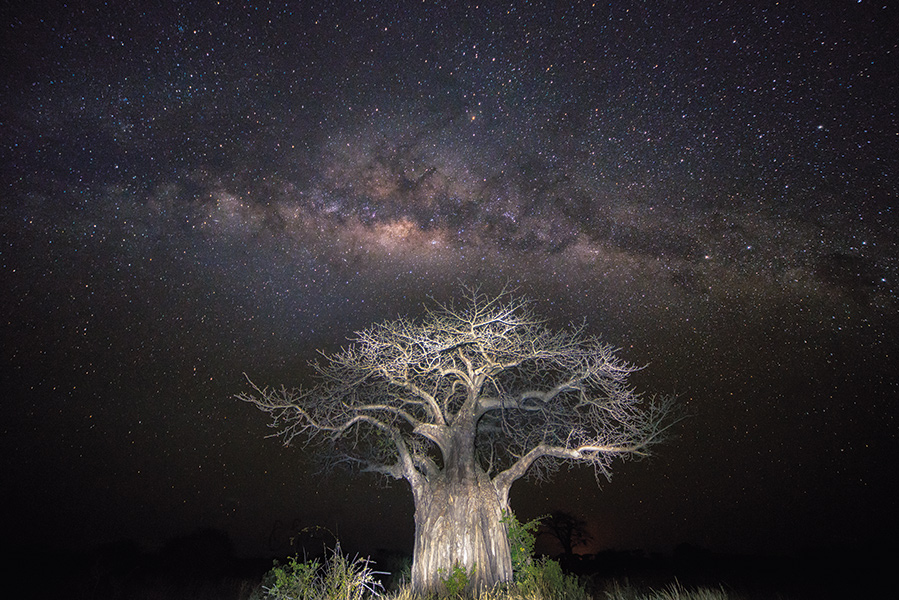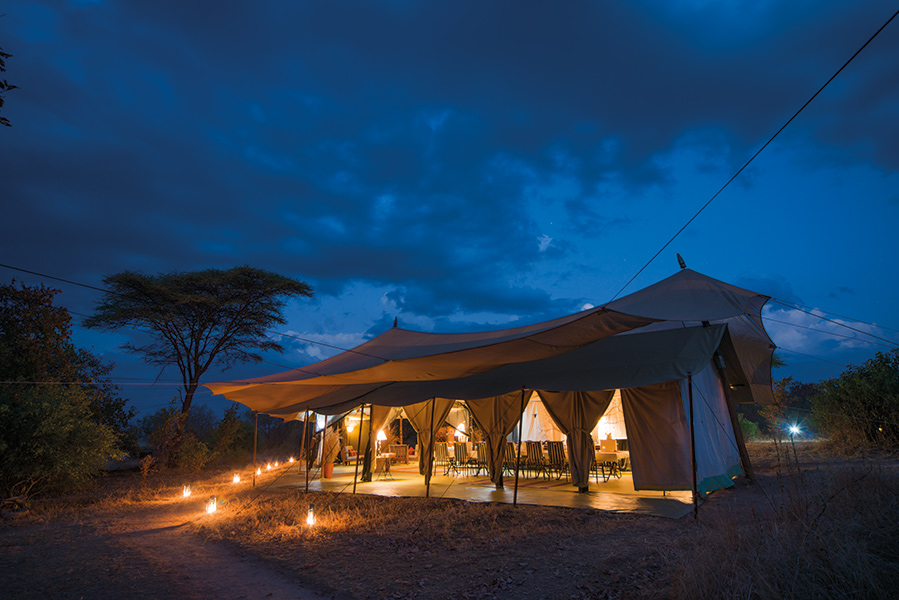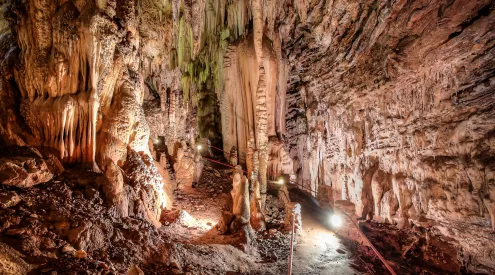Away from expensive, overcrowded East African safari destinations is Ruaha National Park, a remote park that’s home to 10 percent of the world’s remaining wild lions.

Ruaha is critical to carnivore conservation in East Africa, containing important cheetah and spotted hyena populations – and, of course, lions. Prides such as this one sauntering across its grassy plains are common.
The giraffes were nervous. But it was the middle of the so-called yellow season and apocalyptically dry. And the waterhole – a short distance from our vantage point – was irresistible. Yet something wasn’t right and the giraffes sensed it. From where we sat we could see the entire scenario unfolding one agonising step after another. We were deep in Ruaha National Park in south-western Tanzania, roughly on the same latitude as Zanzibar and Dar es Salaam.
The area where we sat watching the drama unfold is remote even by this park’s standards. It’s seldom visited as it’s crowded with tsetse flies. They are possibly the most irritating creatures in existence: slightly larger than a housefly with a bite like a staple gun. However, our discomfort was worth it – or at least promised to be.
Despite its size, there are only a handful of camps in Ruaha and this makes it attractive for visitors enthralled by the promise of East Africa but allergic to the Disney-like travel of its northern cousins. It’s a park for connoisseurs.
Why visit Ruaha?
Most travellers are familiar with the popular northern circuit of Tanzania with its prince of parks, the Serengeti. Spectacular wildlife images market the dream far and wide. The reality is somewhat less romantic. East African parks such as the Serengeti and Masai Mara (in Kenya) are busy and tourists dripping in forex splash around the place, making everything exorbitant.

Located in the transitional zone between Southern and East Africa, Ruaha has some 1600 plant species, but the most remarkable of these are its baobabs – majestic groves which are reason enough to visit.
Connected by radios, the matatus (minibuses) laden with lobsterfied tourists converge on interesting sightings like tsetse flies (and they’re only marginally less painful to bear). It’s made every journey to Tanzania a bittersweet experience for me, and the last one was the worst: an Italian had shouted to scare off a hyena about to catch a leopard a few feet from my lens. I’d vowed never to return. And then I got an invitation to Ruaha. I’d heard about it back in 2003 when Getaway editors had listed it as one of the top 10 parks in Africa. I was intrigued. After an early flight from Johannesburg to Dar es Salaam, I clambered aboard an immaculate Pilatus PC-12 for the two hour hop to the Msembe Airstrip in Ruaha.
Rollercoaster thermals rocked our descent. On approach, an old green Range Rover rushed along the strip to chase away grazing impalas before positioning itself so that a small herd of elephants, which seemed intent on reaching a particularly inviting copse of trees across the strip, were persuaded to wait until our aircraft had passed and halted at the parking area.

The park has large open plains dotted with groves of impressive baobabs. Here a blackbacked jackal peers through the tall grass, which provides a perfect hunting ground for these small carnivores.
A dry 35oC day (it regularly gets over 40o) dragged me down the aircraft’s stairs to meet Lorenzo Rossi, a fair-haired, exuberant Italian with a broad grin, and my guide for the next few days. Like a waiter in a swanky restaurant, he’d explain behaviours as if describing some delectable item on the menu. ‘You seea, Caaaameron, the baobab ess like theees!’ said Lorenzo, his hands articulating the story as he drove.
Not far from the strip an elephant blocked our path and Lorenzo gave me an overview. Spanning more than 20000 square kilometres (roughly the size of Israel), Ruaha is Tanzania’s largest national park. Despite its size, there are only a handful of camps and this makes it attractive for visitors enthralled by the promise of East Africa but allergic to the Disney-like travel of its northern cousins. It’s a park for connoisseurs. The landscapes are dramatic: large open plains, granitic hills, well-developed river courses and evocative groves of baobabs. Its centrepiece is the Great Ruaha River, which snakes through the park before meeting the Rufiji and then the sea. Throughout my visit, we patrolled its banks and the dry riverbeds of the Mwagusi and Mdonya rivers prime game-viewing areas, especially when it’s dry.
Animals are drawn to these lifelines: elephants kick out drinking holes in the sandy beds, lions patrol them and buffalos wallow in the reed beds. Greater kudu (they call them greater kudu but they’re the same thing we get in places such as Kruger) saunter through riverine bush and impala herds mill around the forested areas. Leopards lurk in the shadows. The dirt roads (there isn’t a shred of tar) snake through 20-metre-high doum palms that line the riverbanks.

The tents at Kwihala are spacious, comfortable and rustic enough for that ‘real Africa’ feeling. They are all superbly located so you don’t overlook or feel overlooked by your neighbours. Tent number four and one are particularly well positioned.
Away from the river, the landscape breaks up into open savanna woodlands full of combretums and commiphoras and grassy plains on black soil. Baobabs are prolific. Cheetahs languish on their kills under leadwoods. It was on one of these grassy plains at the foot of a hill where we sat, slapping tsetses and watching giraffes. Nearby, a pride of slender lions hunkered down in the khaki stubble. They numbered 13 or 14, but ears and grass was all we could see. A giraffe would be just the ticket for tonight. The giraffes hesitated, testing the wind. Should we? Shouldn’t we? A step closer. Stop. Turn and retreat a few paces. Nope, it’s fine. Turn back and continue to the waterhole. The pace was infuriatingly slow and the conditions were fast getting too dark to photograph. The foremost lions watched and readied themselves, tensing up like house cats ready to pounce.
Thirty minutes passed. Nobody breathed. Suddenly the giraffes turned and bolted. The pride of bemused lions looked on as they disappeared. Out of the corner of my eye, I saw the reason. One of the pride, which had been a little way off, had nonchalantly walked down the road and messed it all up. The rest of the pride stood up, stretched, yawned and then stalked off. It wasn’t the first time I’d been denied a wild finale in East Africa, but at least in Ruaha there’s only nature to blame.
Environmental snapshot: Africa’s dented prides
It is hard to imagine when you travel to a reserve or park containing lions that they are teetering on being endangered. They seem so ubiquitous. But with all the attention surrounding rhinos, the plight of Africa’s greatest cat has largely escaped attention. Lion populations are a fraction of their former size. Less than a century ago there were an estimated 200000 lions across Africa; now there are fewer than 30000 wild lions. Wild populations have declined some 80 percent in the last few decades, and there are now more captive-bred lions (estimated over 5000) in South Africa than wild lions (estimated to be 2750). Only seven countries are believed to contain populations of greater than 1000 lions Botswana, South Africa, Kenya, Ethiopia, Zimbabwe, Zambia and, of course, Tanzania. Rampant habitat loss to farming, retaliatory hunting by farmers, poaching and disease all play a role in this decline.
Ruaha is home to roughly 10 percent of the world’s remaining wild lions and is critical to the conservation of the species. Researchers such as Amy Dickman from Oxford University and one of the founders of the Ruaha Carnivore Project are working with villagers to help prevent lions from killing their cattle. This inevitably helps prevent retaliatory killings.

Having missed out on their giraffe for dinner, these two lionesses ‘greet’ each other before moving off in search of alternate prey.
When to go to Ruaha
There are two seasons to visit Ruaha. The dry (yellow) season runs from May to November and is best for game viewing as the grass is shorter and wildlife tends to congregate near water. The rains fall from November to April. At its wettest the park is difficult to navigate and many lodges close during this time. It is, however, the best season for birding when more than 570 species are present.
How to get to Ruaha
A number of airlines fly to Tanzania from Johannesburg, but your best bet is Fastjet. Flights start at around R1097 each way, including taxes (admittedly the connection is rough: flights depart Johannesburg at 1am and arrive in Dar around 5am, but at the price it’s a small inconvenience). Expect to pay for check-in luggage and everything else. Coastal Aviation flies from Dar to the safari circuits; one-way flights to Ruaha cost US$365 (R4 001).
Need to know
My trip was three nights and two days in the park. This was too short. Aim to spend at least three full days in the park – five days is even better. Cool khaki clothes are best and a hat is a must. Close-knit long pants, long sleeves and a buff or neck scarf are your best defence in tsetse fly areas. Ruaha is a malaria area so take the necessary precautions.
Where to stay in Ruaha
Most visitors to Ruaha opt to fly in to one of the reserve’s swanky safari lodges. Getaway was hosted by Asilia Africa’s Kwihala tented camp. It’s competitively priced at R1 890 per person per night (South African residents’ rate), including full board, house wine and beer and all game drives. Park fees are US$30 (R328) per adult and $10 (R109) per child per day.
If you’re adventurous enough to self-drive in Ruaha, a vehicle permit costs $40 (R438). Public campsites cost $30 (R328) per adult and $5 (R54) per child younger than 16 a day. ‘Special campsites’ unfenced with no facilities cost $50 (R548) for adults and $10 (R109) for youngsters. You’ll need everything from water to a toileting spade. Tourist bandas (huts) are available from $20 (R219) per night.
Don’t expect much; facilities are not like anything in South Africa. You need to be self-reliant. A Tracks4Africa-enabled GPS is essential.
This article originally appeared in the December 2014 issue of Getaway Magazine.
All prices and conversions correct at time of going to print.




















